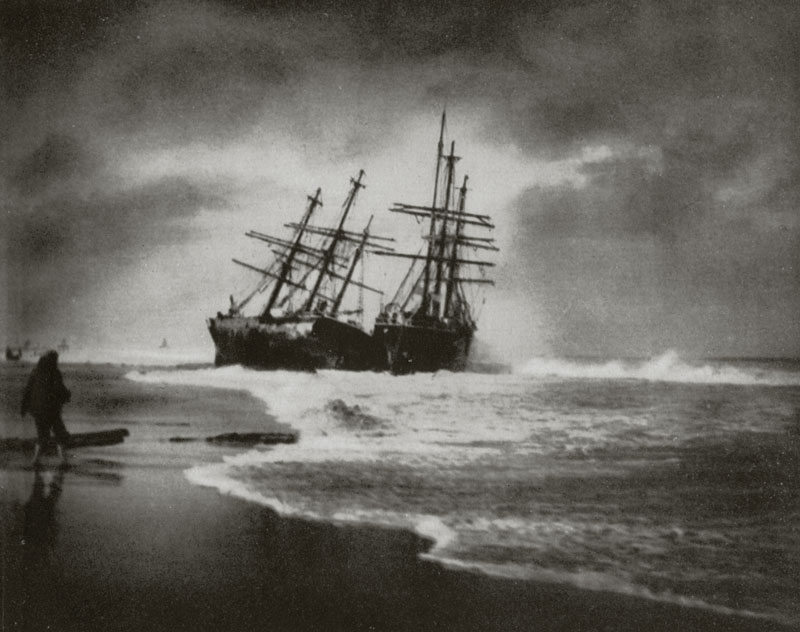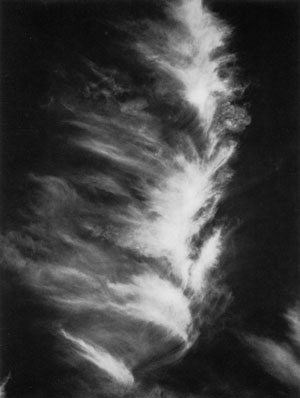Generations
Jack Cato & John Cato
Gael Newton AM
Originally published in the exhibition catalogue:
Time and Timelessness in 100 Years of Australian Photography
Geelong Art Gallery, Geelong, 1996
Jack Cato and John Cato, father and son, are represented in this exhibition by two monochrome landscape studies.
Jack Cato’s After the storm of 1916 and the cloud image from John’s eighteen part Proteus suite of 1974-1979 differ in their respective 'period styles'. Jack Cato formed his style from the Pictorialist art photography of the first decades of this century and his son’s work shows the sensuous yet high contrast graphic quality so much a feature of the 1960s-1970s naturalistic photography.
 |
| Jack Cato, After The Storm |
 |
| John Cato from the series - Proteus |
Both deal with elemental nature as a subject and their mutual aesthetic alignment is with a metaphorical tradition in photography. The earlier image is overt and literary in its narrative aspect; the later work more allusive, symbolist, syncretic and poetic.
Father and son followed different paths in their professional and personal work. Cato senior was a larger-than-life flamboyant character. He was a man of society and the city. His career was as a successful professional photographer specialising in studio portraiture. He had close friendships among the cultured and successful men of Melbourne. Landscape was not his specialty though he enjoyed camping in the bush and sharing yarns over the campfire.
Jack Cato was also a regular newspaper and magazine columnist; his writings include an unpublished novel, a photobook on Melbourne, a jolly autobiography and many specialised articles on photography, stamps and other topics. Jack is best known today for his pioneering historical study The Story of the Camera in Australia (1955) to which he devoted several years after closing his city studio in 1946. He died in 1971 with little inkling of the body of work his son would produce as an artist over the next two decades.
Cato senior began photography as a child and received some assistance with his own work from his elder cousin, the Scottish-born landscape photographer John Beattie. After various apprenticeships young Jack, who preferred the world of the arts, headed back to the 'Old World' and pursued his early professional experience in London portrait studios.
He spent several years away from studio work in South Africa. On his return to Tasmania after World War 1, Jack had studios in Hobart then Melbourne from 1920-1946. Like many of a new generation of more glamorous style of professional photographer after the turn of the century, Cato successfully applied the styling of Pictorial art photography to his professional work. Pictorialism showed its legions of amateur adherents, professionals and advertisers alike how to make-over the prosaic world into the ideal or stylish image.
John Cato also began his photographic instruction helping his father in childhood and continued later as an assistant on The Story of the Camera in Australia. His professional career began just before service in the Navy in World War 11. He worked freelance and in photojournalism before joining the studio of Athol Shmith, a debonair fashion and portrait photographer in 1950. Cato later became director of the Shmith studio.
Unlike his father, John's commercial work is unknown and not presented as any part of his oeuvre. His personal work has been in landscape studies dating from the early 1970s. Like Shmith, from the mid 1970s Cato left commercial practise to teach creative photography in art colleges.
His known work comprises precisely structured sequences of images structured according to the forms and meter of poetry and music. These begin with the fifty two colour photographs of Earth Song 1969-1970 which established the form of subsequent suites.
The first major work is titled Essay 1 (1971-79) comprising eighty black and white landscape prints prints in five groups Tree - a Journey (1971-73)(18), Petroglyphs ( 1971-1973)(14) Seawind (1971-1975) (14) as well as Proteus (18) 1974-1977 and Waterway 1974-7916.
Essay 11 (1977-82) that followed was also in parts; Prologue, Alcheringa, Broken Spears, Mantracks, Epilogue. Essay 11 layered landscape with human reference and the specifics of indigenous and European cultural relations considerably before these agendas assumed their current high profile.
John's work has been made with the absolute passion and commitment to landscape - a genre eschewed by many contemporary photographers in Australia and only rarely practised by women. From an early enthusiasm for forestry and geology he has taken himself on demanding excursions into the hinterlands such as Milparinka and the salt lakes of southern Australia.
This austerity has been somewhat in contradiction to the history of a taste for a temperate intimate nature as in moist 'ferny' bowers beloved by Nicholas Caire and other 19th century Victorian landscape artists. Cato junior has made his many journeys alone or with his life partner and wife Dawn.
John shared with his father a passionate attachment to the classics and classical music as well as Shakespeare, Blake, Eliot and other poets – which like his father he can today recite word perfect. Cato also writes poetry. Unlike his roundly atheist father, in early life John Cato was religious in a Christian tradition but his interest in spiritual traditions later developed to encompass many approaches from Zen to Aboriginal cosmology.
He is known for his quiet humour, goodwill and gentlemanly reserve.
Jack Cato's image of a pair of wrecked sailing ships was made in 1916 on the south east of South Africa near Grahamstown where Cato worked for some years as a photographer illustrating a history of the Kaffir wars. The picture was made when Jack was riding home on his motorbike after a day making landscape photographs. Few photographers would not leap at such picturesque subject matter but the marine disaster also has a long history in art from the sentimental genre works of 18th century marine artists culminating in the sublime pathos of scenes by the 19th century painter J.M.W. Turner.
Cato heightened the drama of the scene he recorded by the addition of richer clouds and by using graphite powder on successive copy negatives until he achieved the suppression of detail and increased tonal contrasts desired by Pictorialists. After the storm sold well for many years as a large framed print at two guineas.
Sailing ships in an age of steam are also symbolic relics of a bygone age when boys could run away to sea. Cato's own sense of mortality or even the passing of his wandering years may well have made the image personally significant. It was the middle of the First World War in which one of his brothers would be killed another badly gassed.
Because of these family losses and the fevers endemic to the tropics Cato returned home to Tasmania in 1920. After the storm and other African pictures gained Cato an Fellowship of the Royal Photographic Society in Great Britain in 1917.
John Cato's Proteus From Essay 1 is a study of the day sky at Milparinka would seem to be an abstracted detail of the father's picture. The final orchestration of Proteus is founded on the established meter in poetry of the sonnet. Its focus is deliberately on wispy cirrus clouds.
There is a certain drama in the strong contrast the image is not reworked) achieved by employing filters, printing and exposure strategies to enhance the relief effect of light against dark. Cato's cloud series is named for the figure from Greek mythology of the Titan who was half-human and compelled to answer the truth about the future providing you could catch or recognise him.
As a shape-changer Proteus eluded all.
The series was first conceived in 1969 when John Cato was asking questions of the future following the death of his mother and the imminent lapse of his father into blindness. With his father, John shared a passion for transcendent language of Shakespeare, the Greek and Latin classics, Lewis Caroll and classical music. The landscape essays specifically being inspired by the lines from Shakespeare's As You Like It which in Act 1, scene 1 speaks of books in running brooks /sermons in stones and good in everything. Both landscape studies by Cato & son are documentary only in the sense that the scenes existed and were made into photographic art works.
The language is that of metaphor not reportage
In Proteus the clouds are not the expression of angst ridden romanticism but in a curious way bring out his father’s rather jocular quip that photography was a matter of ‘bringing out the line and shaping the curve’ which lay hidden in the ordinary. Where the sources of Jack Cato's image can easily be located in the fine arts, John Cato's clouds had to be negotiated around the famous cloud studies of the early twenties by American photographer Alfred Stieglitz which were part of a symbolist theory of equivalence between emotion/concept and image. Cato looked at Stieglitz as well as at the clouds of other American art photographers Edward Weston, and earlier still those of Edward Muybridge in order to also then wipe the images and approach the universal through 'my clouds'.
Both images share a faith in photography as potentially a transcendent medium which runs against the grain of the popular perception of photography as a recorder, as a ‘grim reaper’ dealing frozen immortality to the momentary. This alternate tradition in which the Cato’s belong has attracted photographers since the medium's first appearance as the wunderkind of 19th century materialism and signals that in the archive there are many rooms.
Gael Newton AM
References:
Cosier, Ian. Jack Cato 1889-1971, Fine Arts honours thesis, Melbourne University, 1980.
John Cato: Proteus, Light Quest Folio Series No.1, Light Vision Magazine, Melbourne:1980 Notes by Athol Shmith.
Captions:
Images:
After the storm 1916 south east coast South Africa.
Jack Cato, Australia 1889 - 1971
Collection: National Gallery of Australia
Proteus - John Cato
From the set of eighteen images in the suite Essay 1 (1971-1979)
Collection Waverley City Art Gallery (now Monash Gallery of Art)
Essay was originally published in the exhibition catalogue 'Archival permanence: Time and Timelessness in 100 Years of Australian Photography', Geelong Art Gallery, Geelong , 1996 (Editted by Vince Dziekan )
The exhibition was held at Geelong Art Gallery 8 Nov. - 8 Dec., 1996; Albury Regional Art Centre 14 Dec. 1996 - 18 Jan. 1997; Horsham Art Gallery 7 Feb. - 16 Mar. 1997; Waverley City Gallery 4 Apr. - 11 May, 1997.
With essays by Vince Dziekan, Gael Newton and Susan van Wyk.
Artists: Robert Ashton, Brookes Photographic Union, James Pinkerton Campbell, John Cato, Harald Cazneaux, Olive Cotton, Jill Crossley, Norman Deck, Russell Drysdale, Max Dupain, John Eaton, Peter Elliston, Fiona Hall, Graeme Hare, Bill Henson, Ruth Hollick, Pat Holmes, Frank Hurley, Corrol Jerrams, Mark Johnson, Mortyn Jolly, John Kauffmann, Leah King-Smith, Ian Lobb, Margaret Michaelis-Sachs, Tracey Moffatt, David Moore, Grant Mudford, John O'Neill, Axel Poignant, Robert Rooney, Scott, Athol Shmith, Peter Tyndall, Laurie Wilson, Anne Zahalka.
For more on the photographers: Jack Cato and John Cato,
more of Gael Newton's Essays and Articles
|